
An exarch was the holder of any of various historical offices, some of them being political or military and others being ecclesiastical.

The Ukrainian Greek Catholic Church (UGCC) is a major archiepiscopal sui iuris ("autonomous") Eastern Catholic church that is based in Ukraine. As a particular church of the Catholic Church, it is in full communion with the Holy See. It is the second-largest particular church in the Catholic Church after the Latin Church. The major archbishop presides over the entire Church but is not distinguished with the patriarchal title. The incumbent Major Archbishop is Sviatoslav Shevchuk.

The Ruthenian Greek Catholic Church, also known in the United States as the Byzantine Catholic Church, is a sui iuris (autonomous) Eastern Catholic church based in Eastern Europe and North America. As a particular church of the Catholic Church, it is in full communion with the Holy See. It uses the Byzantine Rite for its liturgies, laws, and cultural identity.

The Catholic Church in Ukraine is part of the worldwide Catholic Church, under the spiritual leadership of the Pope in Rome. Catholics make up 10% of the population of Ukraine.

The Slovak Greek Catholic Church or Byzantine Catholic Church in Slovakia, is a sui iuris (autonomous) Eastern Catholic church based in Slovakia. As a particular church of the Catholic Church, it is in full communion with the Holy See. The church is organised as a single ecclesiastical province with one metropolitan see. Its liturgical rite is the Byzantine Rite. In 2008 in Slovakia alone, the Greek Catholic Church in Slovakia had some 350,000 faithful, 374 priests and 254 parishes. In 2017, the Catholic Church counted 207,320 Greek Catholics in Slovakia worldwide, representing roughly one percent of all Eastern Catholics.

Theodore George Romzha was the bishop of the Ruthenian Catholic Eparchy of Mukacheve from 1944 to 1947. Assassinated by the NKVD, he was beatified as a martyr by Pope John Paul II on 27 June 2001.
Basil Takach was the first bishop of the Byzantine Catholic Metropolitan Church of Pittsburgh, the American branch of the Ruthenian Greek Catholic Church.
Nicholas Thomas Elko was an American Ruthenian Greek Catholic and the third bishop of the Byzantine Catholic Metropolitan Church of Pittsburgh. At the age of 46 he became the first American-born bishop of the Ruthenian Greek Catholic Church. He later served as Auxiliary Bishop of the Archdiocese of Cincinnati, a Latin Church archdiocese.
Stephen John Kocisko was the first Metropolitan Archbishop of the Byzantine Catholic Metropolitan Church of Pittsburgh, the American branch of the Ruthenian Greek Catholic Church

The Union of Uzhhorod, was a decision by 63 Ruthenian priests of the Orthodox Eparchy of Mukachevo to join the Catholic Church made on April 24, 1646. Until rediscovery of its founding document in 2016, academics had debated the actual date of union, whether a document had been signed, and even whether the Union of Uzhhorod had even transpired at all.
Petro Parfenii Petrovich was an Orthodox Bishop and a Basilian monk who united the Ruthenian Church with Rome.

The Saint Nicholas Monastery (Ukrainian: Миколаївський Мукачівський жіночий монастир, romanized: Mykolaivskyi Mukachivskyi zhinochnyi monastyr is an Eastern Orthodox monastery located on Chernecha Hora in Mukachevo, Ukraine. It belongs to the jurisdiction of Eparchy of Mukachevo and Uzhhorod of the Ukrainian Orthodox Church. It is a female monastery, headed by hegumenia Epistimiya Sherban.

Manuil Mykhaylo Olshavskyi, O.S.B.M., was the bishop of the Vicariate Apostolic for the Ruthenians in Mukacheve from 1743 to his death in 1767.

Holy Cross Cathedral is a Ruthenian Greek Catholic cathedral of Eparchy of Mukachevo in Uzhhorod, Ukraine. It is dedicated to the Exaltation of the Holy Cross.

Đura Džudžar is a Serbian eparchial bishop of the Greek Catholic Eparchy of Ruski Krstur since 2018. He was previously titular bishop of Acrassus (2001-2018), auxiliary bishop of the Ruthenian Eparchy of Mukachevo (2001-2003), apostolic exarch of Serbia and Montenegro (2003-2013) and Serbia (2013-2018).
Mykhaylo Bradach was a Ruthenian Greek Catholic hierarch. He was titular bishop of Dorylaeum, auxiliary bishop and Apostolic Administrator of the Ruthenian Catholic Eparchy of Mukacheve from 1812 to 1815.
Ivan Bradach, O.S.B.M. was a Ruthenian Greek Catholic hierarch. He was the titular bishop of Rhosus and the last Vicar Apostolic for the Ruthenians from 1768 to 1771 and the first eparchial bishop of the newly created Ruthenian Catholic Eparchy of Mukacheve from 1771 to 1772.
Yosyf Holovach was a Ruthenian Greek Catholic hierarch. He was an auxiliary bishop of the Ruthenian Catholic Eparchy of Mukacheve from 1983 to 2000 as titular bishop of Sozopolis in Haemimonto.
Petro Pavlo Oros was a Greek Catholic Eparchy of Mukachevo hierarch after the Church was suppressed by the communist regime. He was an auxiliary bishop of the Ruthenian Catholic Eparchy of Mukacheve from 1944 to 1953, when he was murdered by an anti-faith police officer.
Vasyl Tarasovych was a church figure in Transcarpathia, Basilian, eparch of Mukachevo and the initiator of the union with the Catholic Church in Transcarpathia.
















